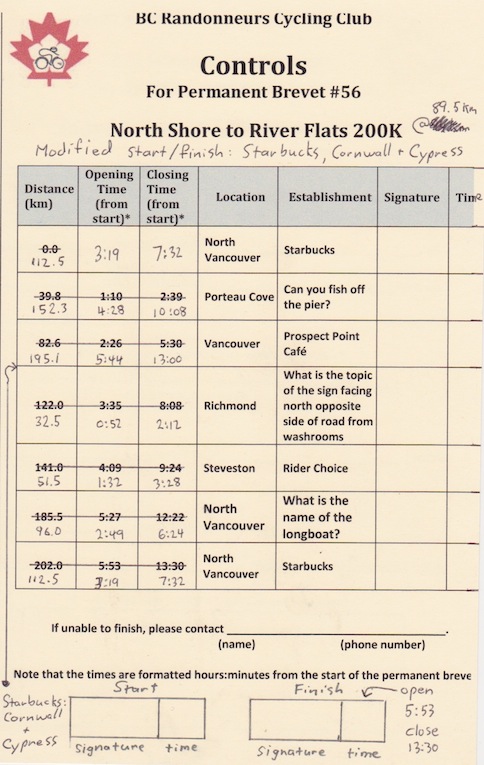Starting a Permanent in the Middle - An Alternate Start Location: Let's say you have discovered an existing permanent route that appeals to you. It's a route which at some point passes close to where you live, but the designated start is remote or inconvenient. Previously this would have needed to be a new route. Now there's a simpler option. You can use your chosen permanent's existing route sheet and control card, though the control card is going to need a few modifications. Let's see how this works with the help of an example. I recently modified a permanent #56 "North Shore to River Flats" control card to start near my home in Kits. The sample card above really says it all, but here is the written-out procedure to help clarify. Step 1. Choose a start control location on the route and then use the route sheet to calculate the distance from the start to your new start location. In my case 89.5 km. Step 2. Calculate the distances of the controls. It's the distance on the original control card minus the distance to your start control. In my case for the Richmond/Iona control: 122.0 - 89.5 = 32.5 km. When you pass the route's original start point you will need to add the total route distance to the control distance. So in my case for the Porteau Cove control: 202.0 + 39.8 - 89.5 = 152.3 km. Step 3. Go to the ACP Brevet Time Calculator on the Randonneurs USA web site. (It's a very useful tool.) Follow the instructions including typing your control distances into the chart. Use the brevet distance higher than your route's finishing distance to get accurate times for the over distance. In my case the distance is 202 km, so I selected 300 as my brevet distance. As the start time enter 00:00 - as always with a permanent, the control opening and closing times are not time-of-day figures, but the times from your start. Click the "Calculate Times" button at the bottom of the page, et voila, your readout: 300km BREVET
Checkpoint Date Time
========== ==== ====
0km start: 01/01 00:00
33km open: 01/01 00:58
close: 01/01 02:12
52km open: 01/01 01:32
close: 01/01 03:28
96km open: 01/01 02:49
close: 01/01 06:24
113km open: 01/01 03:19
close: 01/01 07:32
152km open: 01/01 04:28
close: 01/01 10:08
195km open: 01/01 05:44
close: 01/01 13:00
202km open: 01/01 05:57
close: 01/01 13:28
300km open: 01/01 09:00
close: 01/01 20:00
Step 4. Fill in the new opening and closing times on your control card. Step 5. In the space at the bottom of your control card draw in the signature and time boxes for witnesses to validate your start and finish. Notice that if you start at one of the existing controls you will only need to add finishing signature and time boxes. Step 6. As always, contact one of your permanent co-coordinators to get permission to ride the route, and submit your waiver/entry form. You may be asked to show a copy or scan of your modified control card. Reverse Direction Routes: The principles of modifying the control card for a reverse direction permanent are the same as for the alternate start location option. Principally you need to figure out the new control opening and closing times. The card modification is in fact a little easier for the reverse direction option - you do not need to insert start and finish signature and time boxes. They're already there. A caution about the reverse direction route option. You will need to check the route for one-way road sections, and propose alternate ways through these sections to your permanent coordinators. Additional Considerations: The process is admittedly a bit fiddly the first time, but for future rides on the same route your calculations are already on your previous card. One thing I noticed during my test ride was that my witnesses were more confused than usual when navigating the card. Normally people can easily comprehend the top to bottom progression of the control card, but this starting-in-the-middle thing was confusing for some. Be ready to help them through the confusion - a simple explanation of some sort. Obviously the alternate start system only applies for routes that start and finish in the same place - loop routes or out and back routes. Place to different-place routes (arrow routes) will not work. An arrow route can, however, be ridden in the reverse direction. One final caution for realigning any route. Be careful about choosing a start location that places your first control too close to your start. Any slight delay, like a flat or traffic, might cause you to miss the time cut off at your first control. Eric Fergusson |
